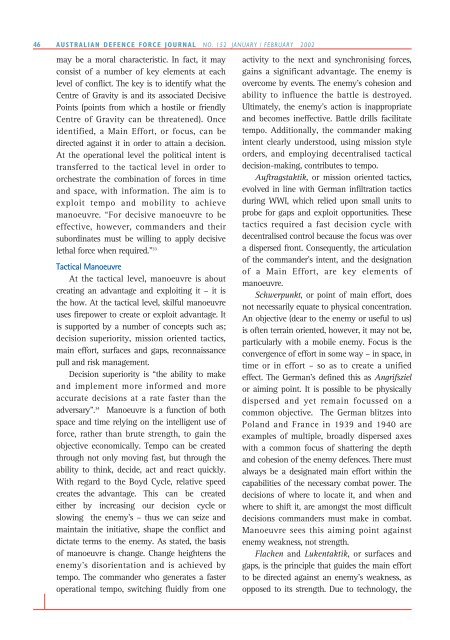ISSUE 152 : Jan/Feb - 2002 - Australian Defence Force Journal
ISSUE 152 : Jan/Feb - 2002 - Australian Defence Force Journal
ISSUE 152 : Jan/Feb - 2002 - Australian Defence Force Journal
- No tags were found...
You also want an ePaper? Increase the reach of your titles
YUMPU automatically turns print PDFs into web optimized ePapers that Google loves.
46AUSTRALIAN DEFENCE FORCE JOURNAL NO. <strong>152</strong> JANUARY / FEBRUARY <strong>2002</strong>may be a moral characteristic. In fact, it mayconsist of a number of key elements at eachlevel of conflict. The key is to identify what theCentre of Gravity is and its associated DecisivePoints (points from which a hostile or friendlyCentre of Gravity can be threatened). Onceidentified, a Main Effort, or focus, can bedirected against it in order to attain a decision.At the operational level the political intent istransferred to the tactical level in order toorchestrate the combination of forces in timeand space, with information. The aim is toexploit tempo and mobility to achievemanoeuvre. “For decisive manoeuvre to beeffective, however, commanders and theirsubordinates must be willing to apply decisivelethal force when required.” 33Tactical ManoeuvreAt the tactical level, manoeuvre is aboutcreating an advantage and exploiting it – it isthe how. At the tactical level, skilful manoeuvreuses firepower to create or exploit advantage. Itis supported by a number of concepts such as;decision superiority, mission oriented tactics,main effort, surfaces and gaps, reconnaissancepull and risk management.Decision superiority is “the ability to makeand implement more informed and moreaccurate decisions at a rate faster than theadversary”. 34 Manoeuvre is a function of bothspace and time relying on the intelligent use offorce, rather than brute strength, to gain theobjective economically. Tempo can be createdthrough not only moving fast, but through theability to think, decide, act and react quickly.With regard to the Boyd Cycle, relative speedcreates the advantage. This can be createdeither by increasing our decision cycle orslowing the enemy’s – thus we can seize andmaintain the initiative, shape the conflict anddictate terms to the enemy. As stated, the basisof manoeuvre is change. Change heightens theenemy’s disorientation and is achieved bytempo. The commander who generates a fasteroperational tempo, switching fluidly from oneactivity to the next and synchronising forces,gains a significant advantage. The enemy isovercome by events. The enemy’s cohesion andability to influence the battle is destroyed.Ultimately, the enemy’s action is inappropriateand becomes ineffective. Battle drills facilitatetempo. Additionally, the commander makingintent clearly understood, using mission styleorders, and employing decentralised tacticaldecision-making, contributes to tempo.Auftragstaktik, or mission oriented tactics,evolved in line with German infiltration tacticsduring WWI, which relied upon small units toprobe for gaps and exploit opportunities. Thesetactics required a fast decision cycle withdecentralised control because the focus was overa dispersed front. Consequently, the articulationof the commander’s intent, and the designationof a Main Effort, are key elements ofmanoeuvre.Schwerpunkt, or point of main effort, doesnot necessarily equate to physical concentration.An objective (dear to the enemy or useful to us)is often terrain oriented, however, it may not be,particularly with a mobile enemy. Focus is theconvergence of effort in some way – in space, intime or in effort – so as to create a unifiedeffect. The German’s defined this as Angrifszielor aiming point. It is possible to be physicallydispersed and yet remain focussed on acommon objective. The German blitzes intoPoland and France in 1939 and 1940 areexamples of multiple, broadly dispersed axeswith a common focus of shattering the depthand cohesion of the enemy defences. There mustalways be a designated main effort within thecapabilities of the necessary combat power. Thedecisions of where to locate it, and when andwhere to shift it, are amongst the most difficultdecisions commanders must make in combat.Manoeuvre sees this aiming point againstenemy weakness, not strength.Flachen and Lukentaktik, or surfaces andgaps, is the principle that guides the main effortto be directed against an enemy’s weakness, asopposed to its strength. Due to technology, the
















